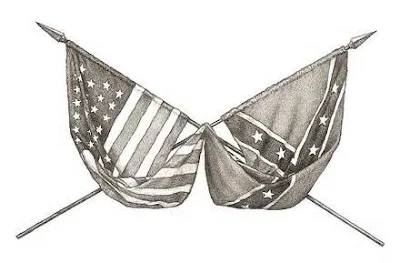The Blue And The Gray
Francis Miles Finch (1827-1907)
By the flow of the inland river,
Whence the fleets of iron have fled,
Where the blades of the grave-grass quiver,
Asleep are the ranks of the dead:
Under the sod and the dew,
Waiting the judgment-day;
Under the one, the Blue,
Under the other, the Gray.
These in the robings of glory,
Those in the gloom of defeat,
All with the battle-blood gory,
In the dusk of eternity meet:
Under the sod and the dew,
Waiting in judgment-day
Under the laurel, the Blue
Under the willow, the Gray.
From the silence of sorrowful hours
The desolate mourners go,
Lovingly laden with flowers
Alike for the friend and the foe;
Under the sod and the dew.
Waiting the judgment-day;
Under the roses, the Blue,
Under the lilies, the Gray.
So with an equal splendor,
The mourning sun-day fall,
With a touch impartially tender,
On the blossoms blooming for all:
Under the sod and the dew,
Waiting the judgment-day;
Broidered with gold, the Blue,
Mellowed with gold, the Gray.
So, when the summer calleth,
On forest and field of grain,
With an equal murmur falleth
The cooling drip of the rain:
Under the sod and the dew,
Waiting the judgment-day,
Wet with the rain, the Blue,
Wet with the rain, the Gray.
Sadly, but not the upbraiding,
The generous deed was done,
In the storm of the years that are fading
No braver battle was won:
Under the sod and the dew,
Waiting the judgment-day;
Under the blossoms, the Blue,
Under the garlands, the Gray.
No more shall the war cry sever,
Or the winding rivers be red;
They banish out anger forever
When they laurel the graves of our dead!
Under the sod and the dew,
Waiting the judgment-day,
Love and tears for the Blue,
Tears and love for the Gray.
Hailed as a national classic from the moment of its publication in 1867, this poem is perhaps the most touching and expressive of all the "reconciliation poems" written after the War's end. It was inspired by the following brief news item, which appeared in the New York Tribune: "The women of Columbus, Mississippi, animated by nobler sentiments than many of their sisters, have shown themselves impartial in their offerings made to the memory of the dead. They strewed flowers alike on the graves of the Confederate and of the National soldiers."
 |
| Francis Miles Finch (1827-1907). |
Francis Miles Finch (1827–1907), a judge, law professor,
and poet, was deeply moved by the story of the women of Columbus,
Mississippi, who in 1866 -- only a year after the end of the War Between The States -- decorated the graves of both Union and Confederate dead.
In the town of Columbus, Mississippi, a few Union soldiers killed at the battle of Shiloh were
buried in the local cemetery along with the much larger number of
Confederate soldiers. In 1866, four women from Columbus decorated the
Confederates' graves and decided to honor those of the Union soldiers as
well. They also sent notes condolence to the northern soldiers'
families. Based on this act of commemoration and conciliation, Columbus,
Mississippi considers itself as
the originator of Memorial Day -- although several other American cities also make that claim as well.
Seeing the moment as a symbol of reconciliation, Finch composed “The Blue and the Gray” as a commemoration honoring the universality of mourning in the North and South in the years preceding the war's end. through the acknowledgment of mutual sympathies, he epitomized the new national tradition of memorializing our American dead.
Seeing the moment as a symbol of reconciliation, Finch composed “The Blue and the Gray” as a commemoration honoring the universality of mourning in the North and South in the years preceding the war's end. through the acknowledgment of mutual sympathies, he epitomized the new national tradition of memorializing our American dead.























































